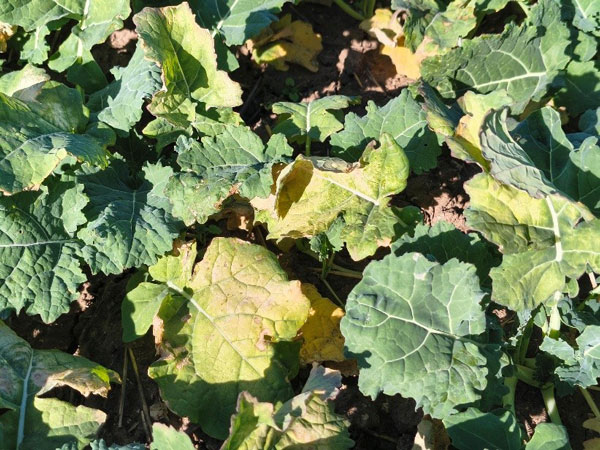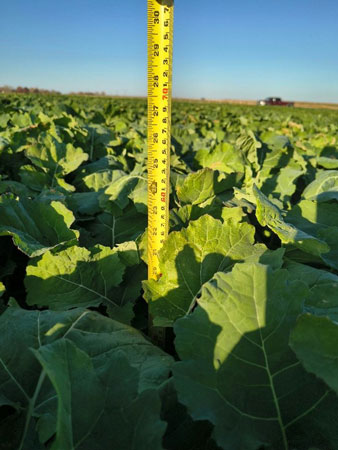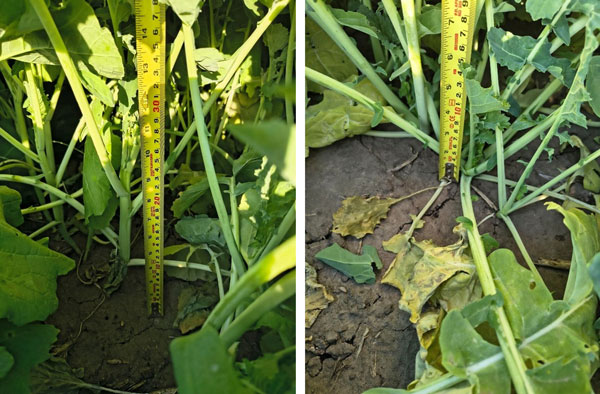Soil moisture conditions were very favorable for winter canola establishment in 2025. Abundant soil moisture and warm temperatures allowed for rapid emergence, which is critical for attaining the right amount of top growth heading into the winter months.
Planting dates in 2025
Soil moisture conditions dictated planting dates for winter canola in 2025. The most challenging issue with planting canola was waiting for the soil to dry out. This delayed planting beyond the optimum date for some producers. Even though planting may have occurred later, in most cases, warm temperatures throughout October allowed adequate fall growth to develop before winter (Figures 1 and 2). Winter canola variety trials in Caldwell, Hutchinson, and Norwich all exhibited this desirable amount of growth by mid-November.

Figure 1. Winter canola variety trials at the South-Central Experiment Field near Hutchinson, KS, on November 18, 2025. The field was planted on September 29. Photo by Mike Stamm, K-State Department of Agronomy.

Figure 2. Winter canola plant at the correct stage for overwintering, with 8 true leaves and 8-10 inches of top growth, at the South-Central Experiment Field near Hutchinson, KS on November 18, 2025. Photo by Mike Stamm, K-State Department of Agronomy.
Temperatures have been cooler recently, and we have seen a few hard freezes. Bleaching of leaves is a common sight after a hard freeze (Figure 3). This is a natural occurrence as the plants take on an overwintering appearance.

Figure 3. Bleaching of canola leaves because of a hard freeze at the South-Central Experiment Field near Hutchinson, KS. Photo by Mike Stamm, K-State Department of Agronomy.
Early planting and excessive fall stem elongation
In some locations, soil moisture was available early in the planting window, allowing for early planting. A few fields have achieved, or were on the verge of achieving, too much fall growth before cooler temperatures arrived this fall. In the pictures that follow, we see an excessively large crop canopy leading to fall stem elongation.
Stem elongation in the fall -- not to be confused with bolting, i.e., stem elongation with visible flowering structures -- may occur because:
- The crop was planted too early
- The crop was seeded at higher-than-optimal plant populations
- Excessive soil fertility is present (particularly nitrogen)
- An unusually warm fall persists
- Selection of a poorly adapted cultivar
- A combination of any of these factors
For example, closely spaced and crowded canola plants increase early plant-to-plant competition for light. This “reaching” for light may lead to an extension of the growing point above the soil surface. Any time the growing point (rosette) is elevated, the chances for winterkill are increased because overwintering plant parts are in an unprotected position above the soil surface.
Because soil moisture was plentiful, winter canola breeding nurseries near Manhattan, KS, were seeded on the early side of the planting window on September 13. The warm temperatures that followed planting allowed the crop to attain more above-ground biomass than desired. Figure 4 shows a leaf canopy measuring between 20-24”. Looking below the canopy, some varieties prone to fall stem elongation are showing a growing point about 8” above the soil surface (Figure 5, left). However, other varieties that are not prone to fall stem elongation are showing a growing point at the soil surface (Figure 5, right). The varieties with the elevated growing point may succumb to winterkill if bitterly cold temperatures arrive. The canola breeding program actively selects against this type of growth habit, so having this selection pressure should be beneficial for screening out unwanted materials. Also, a very warm fall, with little cold weather to slow growth, was another factor leading to excessive growth.

Figure 4. Winter canola breeding nursery at Agronomy North Farm, planted on September 13, 2025. Photo by Mike Stamm, K-State Department of Agronomy.

Figure 5. On the left, the growing point is extended 8” above the soil surface. On the right, the growing point is anchored at the soil surface. Photos by Mike Stamm, K-State Department of Agronomy.
Effect of canola size on winter survival
Canola overwinters and is the most tolerant of cold temperatures in the rosette growth stage. At this stage, the crown develops at the soil surface with larger, older leaves at the base and smaller, newer leaves at the center. The stem thickens, but its length remains unchanged. For the greatest winter survival, a winter canola plant needs 5 to 8 true leaves, 6 to 12 inches of fall growth, a root collar diameter of ¼ to ½ inch, and an extensive root system. Hardened winter canola can withstand temperatures below 0°F for short periods of time.
On the other hand, canola that has too much top growth (typically 20 inches or more) can succumb to winterkill for a number of reasons, including overuse of available soil water and nutrients, stem elongation above the soil surface, and physical damage to the unprotected crown as winter temperatures arrive.
How the crop will ultimately overwinter depends upon numerous factors, but acclimating temperatures (near freezing temperatures with a few harder freezes) will be important to prepare the crop for the coldest winter temperatures. In addition, better survival is often observed when fall temperatures decline gradually, rather than rapidly, before winter fully arrives.
For additional information on canola production, please refer to the recently revised “Great Plains Canola Production Handbook” available through K-State Research and Extension. https://www.bookstore.ksre.ksu.edu/pubs/MF2734.pdf
For more information about canola growth and development stages, please consult the K-State Canola Growth and Development poster: https://www.bookstore.ksre.ksu.edu/pubs/MF3236.pdf
Mike Stamm, Canola Breeder
mjstamm@ksu.edu